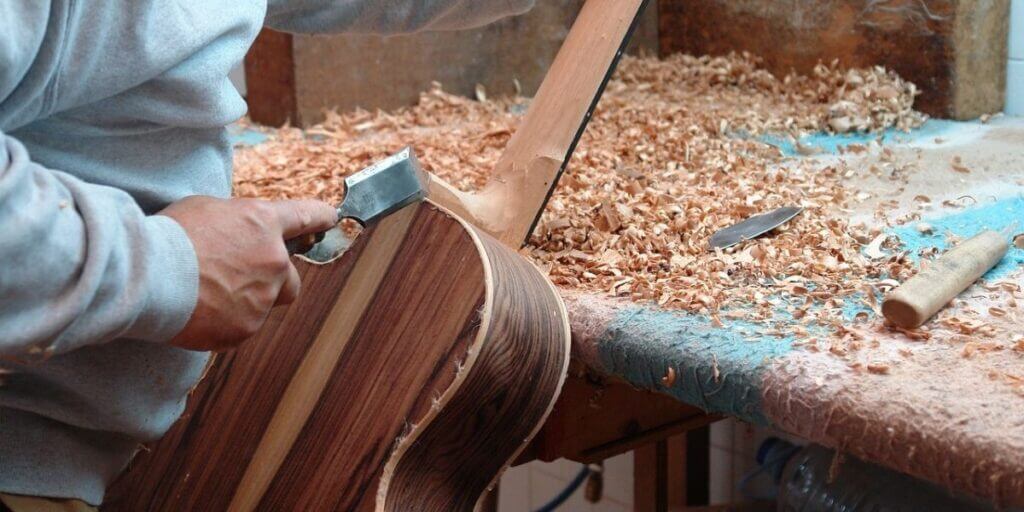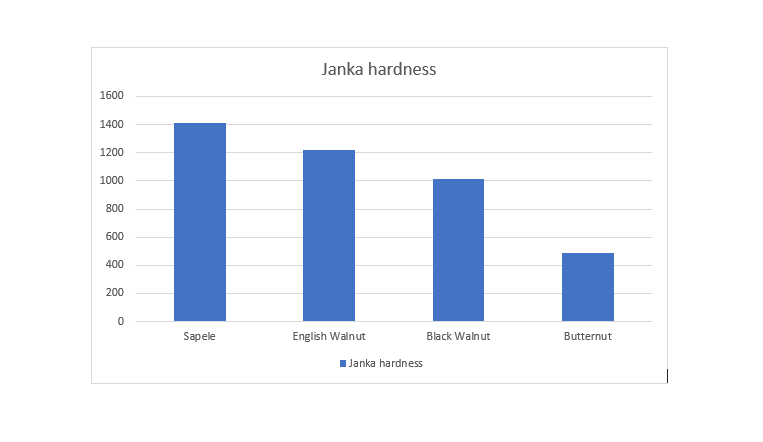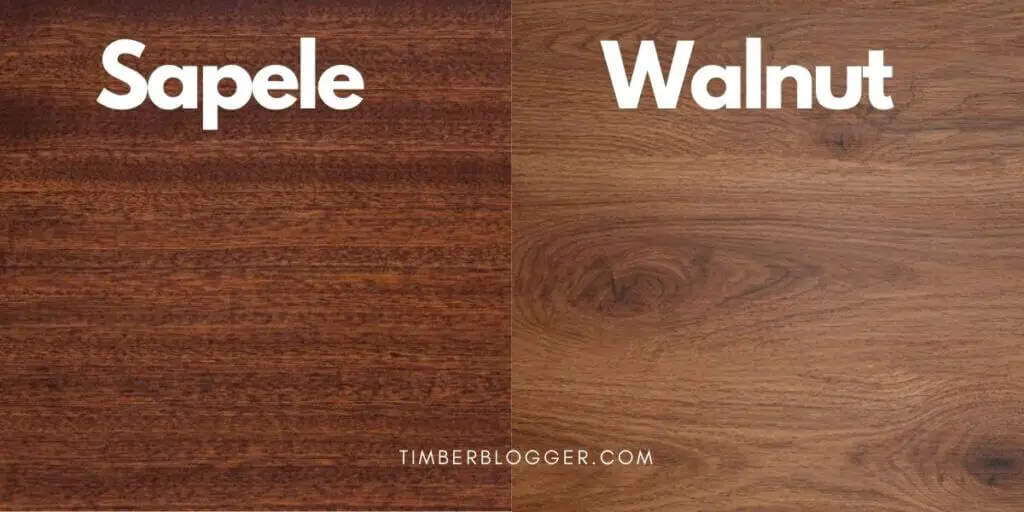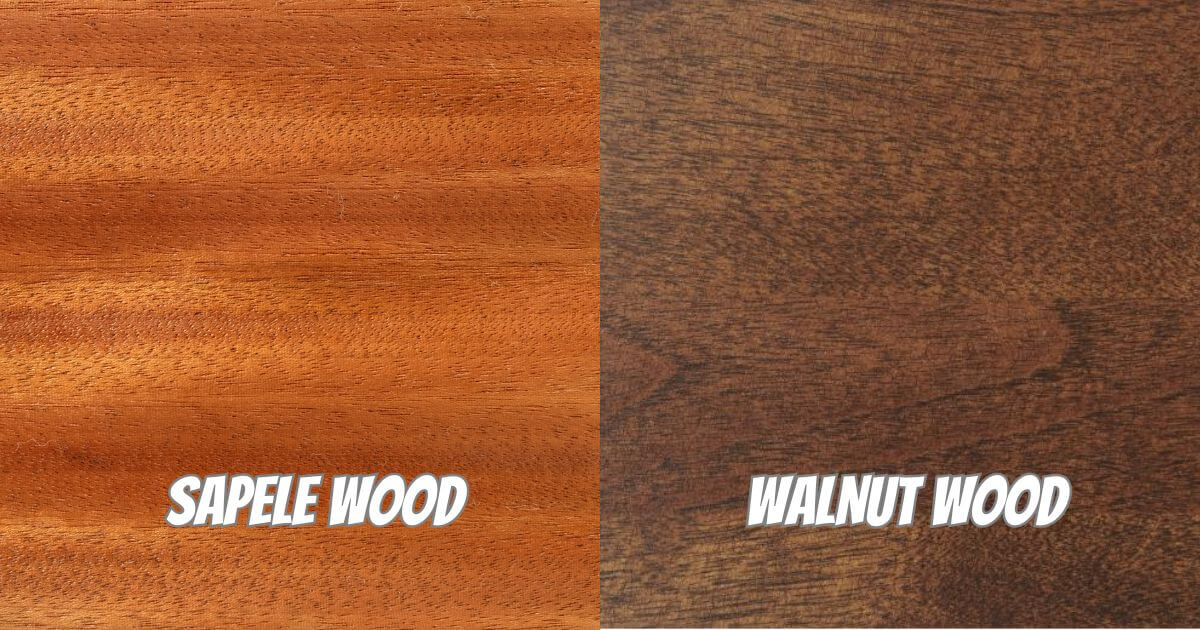Sapele wood is golden to dark reddish-brown, while walnut wood is lighter pale brown to dark chocolate brown. Sapele wood is stronger and harder than walnut wood.
But in the United States, walnut wood is more popular for furniture purposes than sapele, while sapele is more popular for musical instruments.
Sapele Wood
Sapele is a golden to dark reddish brown wood hardwood from a deciduous tree. It is used for furniture, cabinets, doors, and musical instruments. It is also known by another name, Sapelli or Sapele Mahogany. Sapele wood is also considered an alternative to Mahogany because it looks very similar and cheaper.
“Sapele” name comes from the city of Sapele in Nigeria. Its origins are in West Africa. It is found most commonly in Tanzania, Nigeria, and Ghana. Sapele is essential to the economy of Nigeria because of Sapele’s large export volume. Sapele wood is popular due to its hardness, dark brown color, and well-finishing properties.
Walnut Wood
Walnut wood is one of the most popular hardwoods, famous for its dark brown color, strength, and durability. It is primarily used for domestic furniture and flooring.
There are several walnut species, but the most common walnut tree species are Black Walnut, English Walnut, and Butternut (also known as White Walnut and Oil Nut). The English walnut originated in Iran (Persia), the black walnut is native to eastern North America, and the Butternut is native to the eastern United States and Southeast Canada.
Black Walnut vs English Walnut vs Butternut
| # | Black Walnut | English Walnut | Butternut |
| Scientific Name | Juglans nigra | Juglans regia | Juglans cinerea |
| Tree height | 100-120 ft (30-37 m) tall, 2-3 ft (.6-1 m) trunk diameter | 80-115 ft (24-35 m) tall, 5-6 ft (1.5-2.0 m) trunk diameter | 65-100 ft (20-30 m) tall, 2-3 ft (.6-1 m) trunk diameter |
| Janka hardness | 1,010 lbf | 1,220 lbf | 490 lbf |
| Color | Lighter brown to a dark brown. | Lighter brown to dark chocolate. | Medium to light tan color. |
| Workability | Good workability | Good workability | Good workability |
All the species of walnuts have their own different qualities and properties. Depending on their various properties, they have other uses. Some species are perfect for flooring, and some for carving and furniture.
Difference Between Sapele and Walnut Wood
| # | Sapele | Walnut |
| Scientific Name | Entandrophragma Kilindricum. | Juglans. |
| Color | Colors range from light pink to brown and gold to red. Color tends to darken with age. | Light brown to dark chocolate, with some blonde or yellow as well. |
| Dried Weight | 42 lbs / ft3 (670 kg / m3). | 38 lbs / ft3 (630 kg / m3). |
| Janka hardness | 1,410 lbf (6,280 N). | 1,010 lbf (4,500 N). |
| Workability | Workability is not very good. Troublesome to work in some machining operations. | Typically easy to work. |
| Application | Veneer, cabinetry, flooring, plywood, furniture, boatbuilding, musical instruments. | Veneer, Musical Instruments, Flooring, Carving and turning, and Rifle and shotgun handles. |
Uses
Sapele
Sapele wood is considered perfect for making the guitar’s body. It gives a better dark color and also bends easily. So many guitar makers love to use it. It is harder than African mahogany.
So, it is also a great option for flooring because of its good hardness. Scratches and damage do not occur easily. Some boatmakers also like Sapele because it is strong marine timber.

Walnut
There are three main species of walnuts. They have different colors and properties depending on what they are used for. Generally, walnut is used to make cabinets, flooring, furniture, wood veneer and more.
Black walnuts are mainly used to make knick-knacks (small decorative objects, especially used in a house), carvings, and gunstocks due to their rich dark brown color.
English Walnut is used for guitar/instrument, woodturning, wood carving, automotive / aircraft, and boat interiors.
Butternut wood is used in veneer, carving, furniture, interior trim, boxes, and crates. Butternut wood can be easily worked with hand and machine tools. As the name itself suggests, it is a very soft wood that can be easily curved and cut. It gives a good finishing look after polishing and painting.
Sapele vs Walnut Wood : Workability
Sapele Wood
Sapele wood has interlocking grains. These interlocking Grand Sapele are formed during tree growth. The interlocking grains make it difficult to operate with some machines and another reason is that it is hard, making it difficult to work with small tools. The surface of the wood reacts strongly when in contact with the blade so a sharp blade is required to work on it.
After finishing and polishing it gives a good finish and gives a great look. In final words it must be said that the functionality is not easy but the end product turns out quite nice.
Walnut Wood
Some varieties of walnuts are great for functionality, but some are not. Due to the irregular grain of some species, they can be difficult to work with, such as the black walnut and English walnut species. Nevertheless, walnut wood is easier to work with than Sapele wood.
With butternut, this can be done easily with both hand and machine tools because it is soft. Its raised grain can be easily cleaned with fine-grain sandpaper and gives a good finish.
Which Wood Is More Readily Available: Sapele or Maple Wood?
Sapele Wood
Sapele wood is available in sufficient quantity in West Africa, and its demand is being met in other countries due to a population decline of more than 20% in the last three generations. It is on the IUCN Red List. Many countries are working on increasing their productivity, which is expected to be easily accomplished over the next few decades.
Walnut wood
Black Walnut: Black walnut is widely used due to its popularity and easily available in the market.
English Walnuts: English walnuts are expensive and not easily available in the market. But still, small demands can be easily fulfilled. Due to low availability, it is mostly seen in veneer and plywood.
Butternut: It is easily available in the market in the form of lumber and blocks. Its native country is North America, but it is also being grown in many other countries, so their demand can be easily met.
Which Wood Is More Expensive: Sapele or Walnut?
The relative cost of Sapele and Walnut wood can vary based on factors such as location, availability, and market conditions. Generally, Walnut wood tends to be more expensive than Sapele. Black Walnut, in particular, is highly valued for its rich color and is often considered a premium hardwood, contributing to its higher price compared to Sapele wood.
Sapele vs Walnut Hardness
Sapele, English walnut, Black walnut our Butternut has the highest number of Janka hardened Sapele wood. So Sapele is considered better for flooring due to the high hardness.

Sapele vs Walnut Color

Sapele
Sapele’s heartwood color ranges from golden to dark reddish-brown and gradually becomes darker with time. Sapele is famous for its fine, uniform texture and good natural luster.
Walnut
English walnut wood
Walnut species also change their color over time, like sapele. The color of English walnut varies from light brown to dark chocolate brown.
Black Walnut wood
It is found in color ranging from light brown to dark chocolate brown. Sapwood is light yellow-brown to almost white.
Butternut wood
Its color is not as dark as an English walnut and black walnut. This wood’s heartwood is usually light to medium brown, sometimes reddish.
Which Wood Is Good for Cutting Boards: Sapele or Walnut Wood?
Sapele wood is truly an incredible wood for cutting boards. It is twice as hard as mahogany and twice as hard as walnut (all species). Its hardness protects it from dents, and the dark color gives it a luxurious look.
Black walnut and English walnut are also good options for cutting boards. It appears rich, dark chocolate and brown, at 1010 on the Janka Scale. Walnut wood is not as hard as the Sapele, but it is suitable for the cutting board. It gives high durability and a high-contrast feel.


Comments are closed.